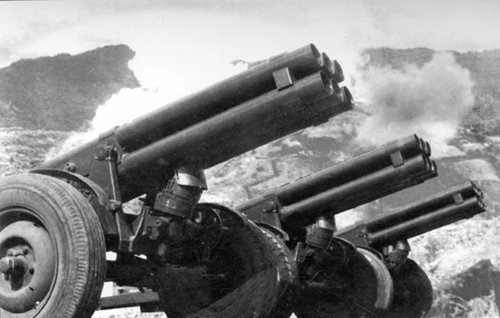According to Assoc. Prof., Dr., Senior Colonel Nguyen Van Sau, Deputy Director of the Institute of Military History, the vivid example in international support for Vietnam was the solidarity of the people of the three Indochinese countries in the fight against the common enemy. They created the most favorable conditions for each other to make resistance war successful.
In Southeast Asia, Myanmar was among the first countries to establish friendship ties with the Democratic Republic of Vietnam. In 1947, Vietnam set up its first liaison agency in Yangon. In 1948, the two sides agreed to upgrade the liaison agency into the Information Dissemination Office to promote dissemination, publish Vietnam News Agency bulletin in more foreign countries and promptly send international news home to serve the direction on the resistance war.
    |
 |
|
Soviet Union-manufactured 122mm multiple rocket launchers that China gave to Vietnam in the final days of the Dien Bien Phu Campaign |
Thailand also gave early and effective support to Vietnam. Under the leadership of then Prime Minister Pridi, the Thai government showed strong support and trust in Vietnam. They created job opportunities for tens of thousands of overseas Vietnamese. They also lent land for Vietnamese to build guerilla bases, equipped some small Vietnamese units with weapons to help them fight against the French colonialists when they returned home.
After China officially established diplomatic relations with the Democratic Republic of Vietnam on January 18, 1950, the Soviet Union and other socialist countries in turn recognized and formed the same ties with the country. This was really a victory and huge support in terms of politics for Vietnam. Since then, China, the Soviet Union, and other socialist countries started giving support to and providing aid, including materials and equipment, for Vietnam's resistance war.
On behalf of the Communist Party of China Central Committee, then President of China Liu Shaoqi affirmed the determination to support Vietnam in the resistance war against the French colonialists. Particularly, China trained some military units, sent advisors and supplies to help Vietnam during the Dien Bien Phu Campaign.
Notably, 1,700 tons of rice provided by China made up 6.8% of the total amount of rice mobilized for the Dien Bien Phu Campaign, while 3,600 105mm artillery rounds reinforced for Vietnam by China in late 1953 accounted for 18% of the total number of artillery shells used. Moreover, China gave an additional 7,400 105mm artillery rounds to the Vietnamese military even though such shells were scarce after the Korean War. In the final days of the Dien Bien Phu Campaign, China continued to reinforce Vietnam with B-10 recoilless rifles and twelve 122mm multiple rocket launchers. These weapons were used in the final offensive on the afternoon of May 6, 1954.
The Soviet Union gave Vietnam a number of items of strategically-military and economic significance in aid. Vietnam's statistics showed that from May 1950 to June 1954, among 21,517 tons of international aid with a total value of 54 million rubles, seventy six 37mm anti-aircraft guns, Katyusha rocket launchers, all K50 submachine guns and 685 transport automobiles were from the Soviet Union.
The assistance from the French Communist Party and French people was also significant. The French people called the war waged by France in Indochina a dirty, unjust, reactionary war against the freedom of the Vietnamese people. By August 1953, 82% of the French people had agreed to end that war of aggression.
Senior Colonel Nguyen Van Sau shared that the French Communist Party sent a number of party members to help Vietnam do military demobilization work in the French military. Apart from the courageous action of female worker Raymonde Dien who lay on the railway track in an attempt to stop the train which carried weapons and soldiers from France to Vietnam, French friends pro-actively met with Vietnamese delegates at international forums and congresses of students, youths and women, asking them to bring home many gifts, newspapers, letters, and money. French organizations, such as the General Trade Union, the Women's Federation, and the Youth Federation launched numerous creative forms of struggle. They included collecting signatures demanding peace in Vietnam to give to city councilors, parliamentarians, ministers, and president; holding protests nationwide; organizing “For Vietnam” meetings; and launching ballot boxes demanding peace in Vietnam.
Translated by Mai Huong